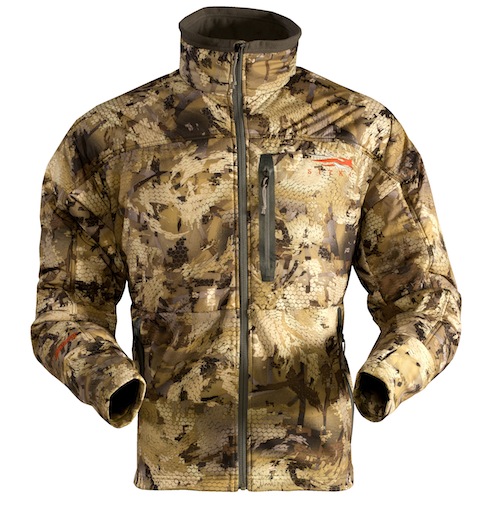 Sitka Gear has long been a leader in hunting apparel, but until 2012 the company had designed its gear — a high-tech layering system with next-to-skin, insulating and outerwear layers — specifically for big-game hunting. Waterfowlers rejoiced when Sitka debuted a complete new waterfowling line in January, offering technical features to duck and goose hunters.
Sitka Gear has long been a leader in hunting apparel, but until 2012 the company had designed its gear — a high-tech layering system with next-to-skin, insulating and outerwear layers — specifically for big-game hunting. Waterfowlers rejoiced when Sitka debuted a complete new waterfowling line in January, offering technical features to duck and goose hunters.
The line features the new GORE™ OPTIFADE™ Concealment Marsh camo pattern. The pattern is digital concealment, not mimicry — rather than trying to make the hunter look like something, the pattern’s intent is to make the hunter appear to be “nothing” to ducks. OPTIFADE Marsh was developed based on the science of animal vision, engagement distance and angle of attack. Because birds are particularly sensitive to color and continuity with the surroundings, the Marsh micro pattern is as detailed as possible to confuse bird vision. The colors, in particular, have been manipulated to create a great deal of depth. Dr. Jay Neitz, the animal vision scientist who consulted on this project, answered some of our questions about how ducks really see and how OPTIFADE Marsh takes advantage of the differences between human vision and duck vision.
“A striking difference between the visual systems of birds and people is that the bird’s eyes do not face forward like human eyes do,” says Neitz. “Having eyes on the sides of the head gives birds a much wider field of view. Ducks are an extreme example; they have full panoramic 360-degree vision. A person looking at a duck from the back can see its eyes, and a duck can see the person standing directly behind it.
“Vertebrates have two kinds of light-sensitive photoreceptors in the retina at the back of the eye, rods and cones, and these are distinguishable by looking at a duck’s retina under a microscope. Rods are for night vision and cones are for daytime vision and color vision. The anatomy of bird retinas shows that daytime-active birds, like ducks and turkeys, have cone-dominated retinas. This tells us that they are equipped to have extremely good daytime vision and good color vision. It has been possible to identify four different kinds of cones in ducks and other waterfowl. Humans have only three types of cones and ungulates, like deer, have only two kinds of cones. This means that humans have better color vision than deer and ducks have better color vision than people do.
“Ducks are very good at seeing fine patterns. They see more colors than humans and they can see 360 degrees around them. However; ducks have inferior depth perception and lower contrast sensitivity when compared to human vision. Birds need more contrast in a pattern than humans in order to be able to see the pattern as different from solid gray.
“The GORE™ OPTIFADE™ Concealment Marsh uses texture and contrast to create a perception of depth, compensating for the birds’ more limited depth perception. Thus, the depth cues in the pattern become important elements in GORE™ OPTIFADE’S™ ability to break up the human form. The pattern has high contrast to compensate for the poor contrast sensitivity of waterfowl vision. The superior color vision of waterfowl becomes a special problem for designing concealment because they can see colors people cannot. Waterfowl presumably see an extra color in the blue part of spectrum that does not exist in human vision and is invisible to us. They also see an additional extra color that corresponds to the absence of stimulation of their extra blue pigment.
 It is no more possible for us to know what these extra color sensations are like to a duck than it would be for a person who had only seen in black and white to understand what the colors red and green are like. In a black-and-white photograph it is hard for us to see the bright red blooms on a rose bush because the red flower looks the same “color” as the leaves. In the same way, a man-made garment may have colors in it or lack colors compared to natural backgrounds, but the differences in wavelength content could be invisible to people. When two things look the same to people but are physically different, they are called metamers. It is possible that something could look like very good camouflage to people, but to the superior color vision of a duck, the hunter’s clothing would not be metameric with the background and it could stand out like the red blooms on a green rose bush. GORE™ OPTIFADE™ matches the spectral content of natural backgrounds to defeat the superior color vision of waterfowl.”
It is no more possible for us to know what these extra color sensations are like to a duck than it would be for a person who had only seen in black and white to understand what the colors red and green are like. In a black-and-white photograph it is hard for us to see the bright red blooms on a rose bush because the red flower looks the same “color” as the leaves. In the same way, a man-made garment may have colors in it or lack colors compared to natural backgrounds, but the differences in wavelength content could be invisible to people. When two things look the same to people but are physically different, they are called metamers. It is possible that something could look like very good camouflage to people, but to the superior color vision of a duck, the hunter’s clothing would not be metameric with the background and it could stand out like the red blooms on a green rose bush. GORE™ OPTIFADE™ matches the spectral content of natural backgrounds to defeat the superior color vision of waterfowl.”
OPTIFADE Marsh is indeed a unique pattern that will look foreign to some duck hunters. But you’re not trying to fool other hunters, now are you? The full Sitka waterfowl line can be seen at www.sitkagear.com/newproducts. It includes several jackets, parkas, vests and an excellent pair of bibs that offer superior warmth with very little bulk.
More information about GORE™ OPTIFADE™ Concealment Marsh can be found at www.optifade.com .






